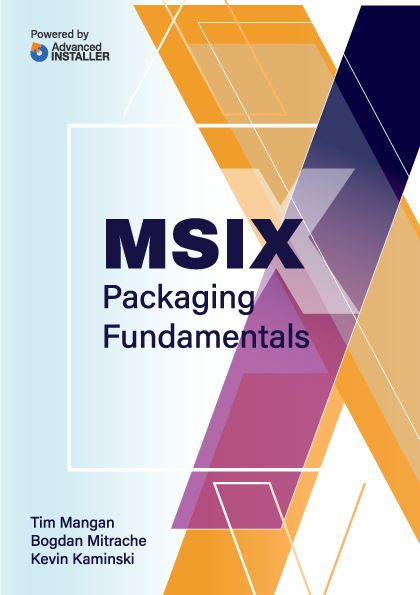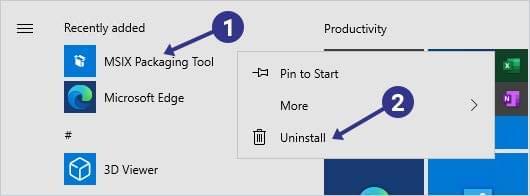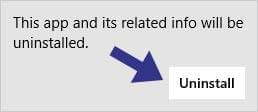Contents
- Overview
- Deployment File Types for MSIX
- MSIX Package Installations
- Upgrades and Downgrades
- Per User Installations
- Standard User Installation
- Application Package Signing
- Using the App Installer App
- Installing App Installer App
- Application Management via App Installer App
- App Installer App from Web Sites
- Uninstall an MSIX Package using App Installer App
- Installing MSIX with PowerShell
- The Add-AppXPackage Cmdlet
- The Get-AppXPackage Cmdlet
- The Remove-AppXPackage Cmdlet
- Using Get-AppPackageManifest
- Deployment with DISM
- Offline & Online Installation
- Provisioning Packages
- MSIX and the Windows Store
- MSIX and the App Installer File
- Configuration Manager and MSIX Deployment
- Using Intune with MSIX
- VDI Meets MSIX with App Attach
- MSIX and App Center

Using the App Installer App
Installing App Installer App
The App Installer application is now included with the operating system, however earlier versions of the OS required it to be obtained and installed from the Microsoft Store.
The App Installer app was built to simplify the installation of MSIX applications. With it, you can access a user-friendly double click method to install applications and avoid the complexity of PowerShell commands.
Another great feature of the App Installer app is that you get meaningful error messages to help you diagnose installation issues. If there are installation issues, the application is designed to provide error messages that help diagnose the application installation issue.
For earlier versions of the OS, the App Installer App may be obtained and installed from the Microsoft Store.

Alternatively, you can open the Windows Store app and search for “app installer”. It should be the first application in the results.
Click Get to install the application. You may be prompted to sign into the store if you have not configured the Windows Store with your Microsoft account.
The application will download and install and no further action or configuration is required to use the features of the App Installer.
Application Management via App Installer App
Manual Software Installation
With the App Installer present on the machine, it is possible to double click both MSIX and AppX applications as well as application bundles and get them to install (similar to an offline installation). There also is the .AppInstaller file that helps define more complicated application installations while providing a framework for light management of application updates.
The App Installer App uses a small GUI that aids the user performing the installation:
- To verify whether the package is validly signed with anacceptable certificate.
- Distinguish new installation, upgrade, and downgrade scenarios.
- Understand dependencies, including modification packageinstallation situations.
App Installer App from Web Sites
The App Installer also allows users to initiate an installation from web accessible URLs that point to either an MSIX/AppX application, application bundles or an .appinstaller file. To successfully host MSIX packages from the web, the following needs to be in place.
Web Server Configuration
- Support for HTTP/1.1: The web server needs to support byte rangerequests from the client to fulfill the communication requirementsfrom App Installer.
- Required MIME Types: New MIME types are needed to support MSIX
File Extension | MIME Type |
|---|---|
.appx | application/appx |
.msix | application/msix |
.appxbundle | application/appxbundle |
.msixbundle | application/msixbundle |
.appinstaller | application/appinstaller |
Required MIME types to host MSIX packages for web consumption
The MIME types in the table above are needed to configure the web server’s response to the incoming request. For example, if you use IIS as a web server to host your MSIX packages, the following settings would be added to the web.config file.
<system.webServer> <!--This is to allow the web server to serve resources with the appropriate file extension--> <staticContent> <mimeMap fileExtension=".appx" mimeType="application/appx" /> <mimeMap fileExtension=".msix" mimeType="application/msix" /> <mimeMap fileExtension=".appxbundle" mimeType="application/appxbundle" /> <mimeMap fileExtension=".msixbundle" mimeType="application/msixbundle" /> <mimeMap fileExtension=".appinstaller" mimeType="application/appinstaller" /> </staticContent> </system.webServer> |
The process is similar for other web hosting platforms.
Create a Clickable Link on a Web Page
If you are using a web page to provide an easy way to distribute the application installation or to share a common link through Emails, the current best-practice is to prefix the URL path to the MSIX package with the App Installer handler.
The App Installer handler is “ms-appinstaller:?source=”. Below is an example of the final string.
ms-appinstaller:?source= https://msixdemo1.azurewebsites.net/MySample.msixbundle |
When you edit the web page that references the MSIX application, add the App Installer handler (ms-appinstaller:) to the relevant HTML link using the source parameter (?source=). You can see an example below where the App Installer handler is added to the href property of an anchor element (<a>), so it contains the full reference.
<html> <head> <meta charset="utf-8" /> <title>Install My App</title> </head> <body> <a href="ms-appinstaller:? source=https://msixdemo1.azurew ebsites.net/MySample.msixbundle"> Install My App</a> </body> </html> |
Uninstall an MSIX Package using App Installer App
The process to remove an MSIX package is straightforward. Simply locate it in the Start Menu and right click, then select Uninstall.

You will be prompted to uninstall the software. Confirm the uninstall action by clicking Uninstall in the prompt.

While quite simple for the end-user, the admin should be aware of the following:
- Like installation, in most cases an uninstall may be performed without elevation.
- By default, this method of installation removes not only the installed package, but also removes any user settings stored in the container and/or application registry hive.
- Removal of a package also automatically removes any modification package to the package. If you wish to remove the modification package only, this is accomplished via theWindows Settings application by locating the application, exposing the advanced details to see the modification packages and uninstalling from there (or via PowerShell).